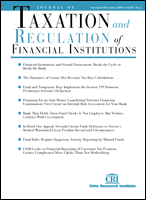Complete Issue
Author: Houman Shadab.
Source: Volume 31, Number 01, Fall 2017 , pp.1-56(56)

< previous article |return to table of contents
Abstract:
This issue begins with an article by Thomas Boczar and Mark Leeds, who discuss tax-efficient hedging in the context of rising interest rates. As the authors note, rising interest rates mean a decrease in the value of bond portfolios; accordingly, they explore how to short sell Treasury securities can help financial institutions with large fixed-income portfolios to hedge against interest rate risk and obtain tax benefits. The Department of Labor’s 2016 fiduciary duty rule applicable to advisers for individual retirement accounts is the subject of our second article. Authors Lee A. Schneider, Lilya Tessler, Alexandra N. Mogul, and Seth Rosenbloom explore the definition of “recommendation” under the rule by focusing on the approach taken by the Financial Industry Regulatory Authority in its interpretation of “recommendation” in the context of its suitability requirements. In our third article, William E. Wilcox, Tanner Bedsaul, Ryan Cahalan and Gabe Dickey discuss Treasury Regulation Section 1.385 on treating intercompany transactions as equity or debt. But the regulation—enacted with an eye toward reducing targeted multinational corporations’ ability to shift income from high-tax countries to low-tax countries and not particularly focused on banks—could nonetheless directly and indirectly impact financial institutions, not all of which are exempt. The authors discuss the history and nature of the rule and its application to corporate treasury transactions, which are likely to become more costly under the rule. John Barrie, in his State and Local column, focuses on two recent developments in California. The first is the Taxpayer Transparency and Fairness Act of 2017, which moves tax procedure to the California Department of Tax and Fee Administration and the Office of Tax Appeals and away from the California Board of Equalization. Mr. Barrie next discusses the June 2017, California Supreme Court case of 926 North Ardmore Avenue, LLC v. County of Los Angeles, which affirmed the ability of localities to impose a documentary transfer tax on transfers of ownership interests in entities that own real property. In a U.S./International column, Alan I. Appel and Michael Hirschfeld discuss updates to the Foreign Account Tax Compliance Act that took place in 2017, as well as applicable best practices. The authors discuss compliance with the FATCA XML reporting schema v2.0 and applicability of the October 24, 2017, deadline for renewing a foreign financial institution agreement. Kevin A. Diehl, in a Banking Developments column, examines the May 9, 2017, decision in Starr International Co., Inc. v. United States, which ruled on the legality of the 2008 tax payer-funded bailout of American International Group. As Professor Diehl notes, the court ultimately ruled in favor of the government due to the shareholders’ lack of standing to bring suit directly under federal law or Delaware corporate law. This issue closes with a staff-written Recent Developments column that covers 2017 developments in housing law and policy, relating primarily to Fannie Mae and Freddie Mac, that demonstrate the continuing impact of the 2008 residential mortgage crisis almost a decade later.Keywords: tax-efficient hedging; Department of Labor Fiduciary Rule; illegal exaction; third-party standing; final Treasury Regulation §1.385; FATCA; California state and local tax developments; Federal housing law
Affiliations:
1: New York Law School.